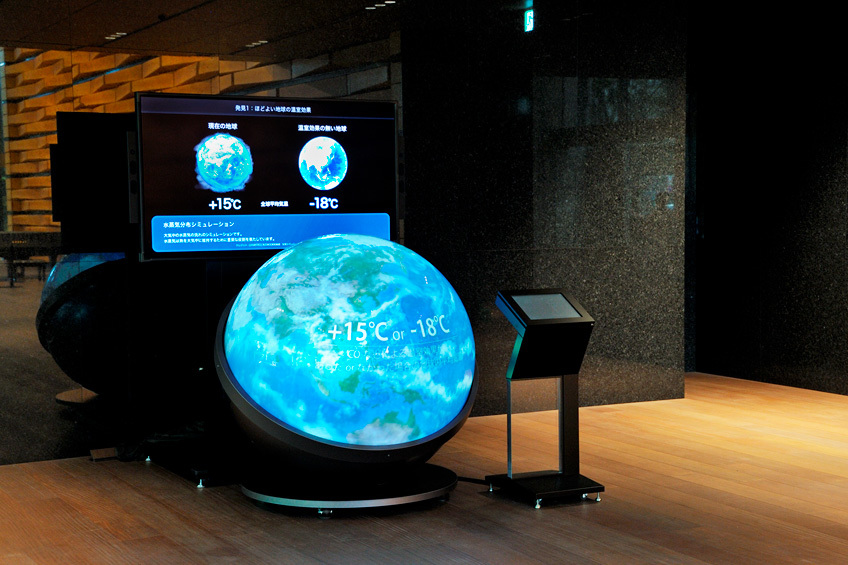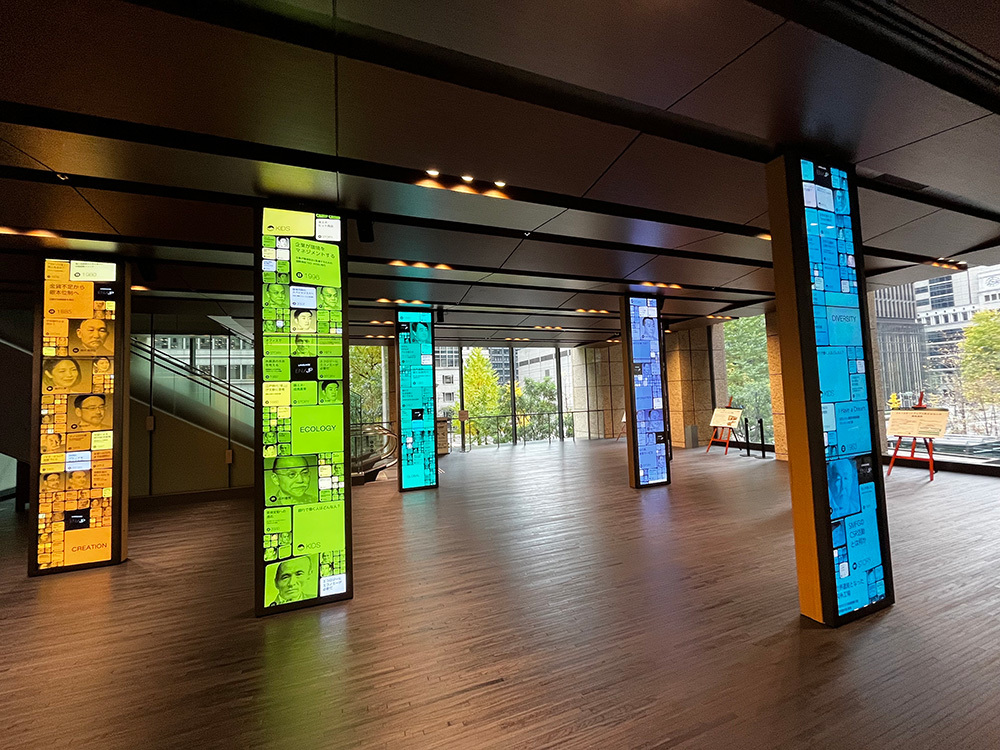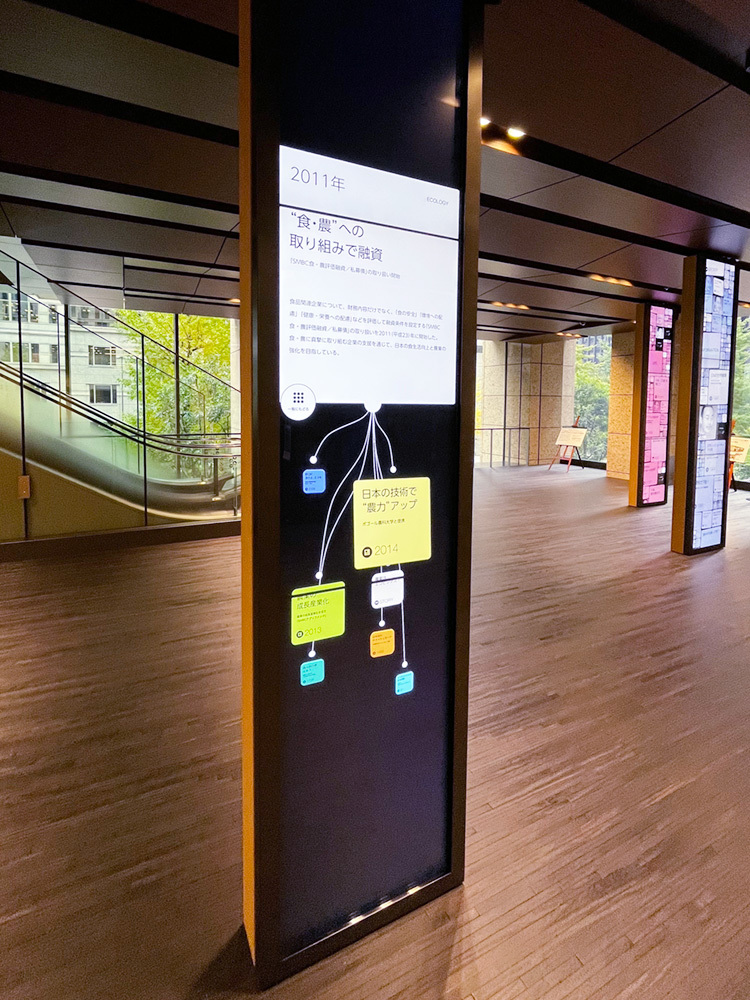Note: This website was automatically translated, so some terms or nuances may not be completely accurate.
A Space to Engage with Finance: Sumitomo Mitsui Banking Corporation's "Financial/Knowledge Landscape"

"Finance" is a theme that people living in modern society cannot avoid, yet it is somehow difficult to approach. How can we make the invisible concept of "finance" something that interests many people? In this article, we will look at how the museum "Finance/Landscape of Knowledge," operated by Sumitomo Mitsui Banking Corporation and themed around "finance," provides hints on how to think about the relationship between finance and oneself.
Reporting and Text: Yuna Mori (PR Consulting Dentsu Inc.)
Financial Literacy Among Japanese People
There was a time in Japan when many people avoided discussing money in front of children. However, with the lowering of the legal adult age to 18 in April 2022, enabling financial contracts from age 18, financial education became mandatory in high schools around the same time. This signifies the dawn of an era where "talking about money in front of children" is now expected. Furthermore, the 2023 (Reiwa 5) tax reform outline confirmed plans to expand the Nippon Individual Savings Account (NISA) system starting in 2024. This means systems are being put in place to enable ordinary citizens to invest more actively than ever before.
However, many may question whether consumers managing these financial products possess sufficient knowledge. As mentioned earlier, financial education only began in schools last year. Furthermore, the Financial Literacy Survey conducted every three years by the Central Council for Financial Services Information shows no change in consumers' financial literacy between 2016, 2019, and 2022. On the other hand, the same survey revealed that 71.8% of respondents answered "Yes, I think financial education should be provided" to the question "Do you think 'financial education' covering life planning and household management should be taught in schools?" This clearly shows a widespread perceived need for financial education. Furthermore, the survey highlighted the necessity of financial knowledge, education, and literacy from various angles, such as the tendency for people with high accuracy rates on financial literacy true/false questions to be less likely to encounter financial problems.
Amidst this, there exists a place where one can engage with "finance" through unique methods rather than traditional classroom learning. That place is Sumitomo Mitsui Banking Corporation's "Financial/Knowledge Landscape."
Thinking by Spinning a Globe
Mitsui Sumitomo Bank is one of Japan's leading megabanks, formed in 2001 through the merger of Mitsui Bank (founded in 1876) and Sumitomo Bank (founded 19 years later in 1895), both of which had merged with several other banks. The "Financial/Knowledge Landscape" operated by Mitsui Sumitomo Bank is located in Otemachi, Tokyo, where the bank's head office is situated. The museum occupies the second floor of the Rising Square building, the Sumitomo Mitsui Banking Corporation East Building, located just across the street from the head office. It opened in 2015, coinciding with the completion of the Sumitomo Mitsui Banking Corporation East Building.

The decision to establish the museum here stemmed from the desire, during the planning of the SMBC East Building, to incorporate initiatives aimed at revitalizing the local area within the building itself. As a company formed through a large-scale merger, it does not primarily convey messages emphasizing the founder's vision or philosophy, unlike many corporate museums.
However, its location is Otemachi, Tokyo—one of Japan's premier financial districts. A short walk away lies the Bank of Japan's Currency Museum, and the same year the "Financial/Knowledge Landscape" opened, the Mitsubishi UFJ Trust Bank Trust Museum also opened in the same area. Most other bank museums typically showcase the bank's role and history in the local community. Yet, this bank chose instead to provide a space for basic financial education accessible to a wider audience.
On the first floor, before entering the museum, stands the "Touchable Earth," a digital globe scaled to one ten-millionth the size of the actual Earth. This world's first interactive digital globe displays various aspects of our planet in real time: weather information, earthquakes and tsunamis, global movements like migratory birds, population growth, global warming, and PM2.5 levels. True to its name, "Touchable Earth," visitors can touch and manipulate the globe themselves, viewing the Earth from various angles.

Why place a globe at the entrance of a financial museum? We asked Mr. Yuki Higuchi from the Management Department of Sumitomo Mitsui Banking Corporation.
"Our society and daily lives are sustained within the vast interconnected systems of this planet Earth. We live in an era where it is essential to constantly consider issues from a global perspective—whether it's ensuring safe and secure living, the sustainability of food, water, and energy, or environmental challenges that nurture diverse ecosystems. The 'Financial/Knowledge Landscape' and the 'Rising Square' it occupies are themed around globally grasping these contemporary challenges and considering finance's role in solving them. To that end, we installed this 'Touchable Earth' as a tool to contemplate the relationship between the Earth and humanity from various perspectives. We also introduce the realities of today's social issues—which change in real time and are interconnected on a global scale—along with the possibilities for their solutions, alongside the activities our bank is undertaking in this space."
This setup enables visitors to recognize the ever-changing relationship between our planet and our lives, fostering a perspective that allows them to approach the subsequent financial world experience with an awareness of the role finance plays within it.
Discovering a New Relationship Between Yourself and Finance: The "Monolith"
After experiencing the "Touchable Earth" and ascending to the second floor, visitors enter a space with multiple pillars emitting video and audio. This is the "Finance/Knowledge Landscape." These three-meter-tall pillars are called "Monoliths," signifying "Pillars of Knowledge." There are eight pillars, each displaying over 500 pieces of content. Beyond the guidance pillar, they are divided into seven categories: Creation, Ecology, Global, Diversity, Information, Life, and Living. All are touch-panel operated, with images of people and content titles, sized according to importance, flowing from bottom to top.

At first glance, some images prompt questions like "Why is this person here?", sparking curiosity. Each monolith functions identically: touching a person's image displays their past thoughts or quotes on finance (for historical figures) or presents text questions followed by footage of their responses (for interviewable individuals). Touching a content title displays its explanation via text or illustrations.
Sumitomo Mitsui Banking Corporation positions this "Financial/Knowledge Landscape" as "a place to discover new relationships between yourself and finance." The aim is less about acquiring knowledge of "finance" itself, and more about using each category as an entry point to discover your own "relationship" with finance. Consequently, when you touch and view the aforementioned images or content, several other pieces of content linked to what you're currently viewing are suggested. In other words, it suggests connections you might not easily notice on your own—such as how "Issue A" and "Issue B" are actually linked, or how "Historical Topic C" and "Current Law D" were enacted within the same historical flow.

Knowledge is a wasted treasure if merely possessed. However, as experienced here, recognizing how acquired knowledge connects to other phenomena—and how these connections foster unprecedented developments—sparks new questions and encourages linking knowledge to different subjects. Each category becomes an entry point, prompting reflection not just on finance, but on the "relationship" between oneself and society, finance included.
For instance, even if you acquire knowledge through reading books or other means before taking action, attempting it alone presents significant hurdles. This stems from several reasons, such as a fixed perspective or biased knowledge. Solving this often becomes easier by viewing the phenomenon and its relationships from different perspectives or knowledge bases, like through conversation with others. This likely allows you to see the relationship between yourself and the phenomenon from a broader, more holistic viewpoint. This "Financial/Knowledge Landscape" explicitly shows this through its monolith, providing numerous mental aids for thinking. Moreover, its operation is simple, and the fact that it can be experienced intuitively is also a plus.
Businesspeople, artists, and manga characters alike
The images flowing onto the monolith are projected upward from the floor, making them easy to touch for children and wheelchair users. As a museum themed around finance, younger elementary school children might still find it challenging to fully grasp and enjoy the content. Nevertheless, sections like "What Do Banks Do?", "Money Encyclopedia", and "Preserving Nature and Protecting the Environment" are tagged "KIDS". Difficult kanji characters are accompanied by furigana readings, and the text is composed in relatively simple language. Furthermore, the interview videos featuring prominent figures from various fields can be experienced through audio, creating an immersive feeling as if you're listening directly to the person themselves, which is fascinating.
The interview videos feature individuals like photographer Naoki Ishikawa, novelist Mariko Asabuki, and artist Noritaka Tatehana – figures who, at first glance, might make you wonder, "Why interview this person about finance?" Of course, there are also interviews with economists, business leaders, and others more directly connected to finance.
Personally, I found the interviews with the former group more interesting. For example, Noriyuki Tatenohana mentioned that the heel-less shoes he created for his graduation project at Tokyo University of the Arts caught Lady Gaga's eye. Starting in April of his graduation year, he designed her shoes for about two years. He explained that while many items were necessary during that time, one crucial element was funding – and a bank account. Funding is an indispensable element in starting any business within our current economic system. It's easy to imagine how difficult it is to secure this independently immediately after graduating from university. He leveraged the power of the financial system to get that initial push.
Stories like this rarely come to light. That's because the idea of deliberately seeking out "financial" stories from writers, artists, and the like doesn't readily occur to people. Yet for those of us living in the modern world, it's difficult to sustain our lives without the financial system. This interview makes us realize that listening to the stories of people seemingly unrelated to finance can be effective for understanding this reality. It shows that this fact applies to me, and indeed to everyone.
The interview features a diverse array of other personalities. Alongside the aforementioned photographer, novelist, and artist, numerous intriguing figures appear, such as Takashi Zaizen, the protagonist of the manga "Investor Z," and rakugo storyteller Taihei Hayashiya.
When people hear the word "finance," some might feel it's distant from their lives and perceive learning about it as having a high barrier. For such individuals, hearing from familiar names or manga characters significantly lowers that barrier, making it easier to step into the gateway of understanding finance.
Thanks to these thoughtful touches, even visitors with some financial knowledge can discover new connections between finance and their lives. It's also perfectly designed to be the first place financial beginners turn to when they want to learn about money.
Financial and Economic Education as a Sustainability Initiative
The SMBC Group, including Sumitomo Mitsui Banking Corporation, positions financial and economic education as one of its sustainability activities. In modern society, various issues related to "money" exist, such as multiple debt problems and financial crimes. Sumitomo Mitsui Banking Corporation aims to realize a society where everyone can live with peace of mind by acquiring the right knowledge about "money," through its commitment to financial and economic education targeting a wide range of generations, from children to adults. "Financial/Knowledge Landscape" exists as a venue for this financial and economic education.
It also serves as a catalyst for contemplating questions like: What has "finance" created for society? What kind of future does "finance" promise? Financial literacy will only grow in importance. Visiting "Financial/Knowledge Landscape" could be a good starting point.
[Editor's Note] (From the Web Dentsu Inc. Editorial Department)
The legendary comedian Charlie Chaplin famously said, "All you need in life is courage, imagination, and some money." This quote perfectly captures the essence of this museum, but the key lies in the word "some."
"Just a little," "a fair amount," "a decent amount," "a reasonable amount"... its interpretation surely varies from person to person.
But consider this: "some money" is essential to sustain the courage and imagination indispensable to life. The exact amount doesn't matter. Whether buying a single leek, launching a business, or traveling to space, "some money" is indispensable.
Experiencing this museum made me suddenly think of that.
Was this article helpful?
Newsletter registration is here
We select and publish important news every day
For inquiries about this article
Back Numbers
Author

Yuna Mori
PR Consulting Dentsu Inc.
Joined the company in 2009. A PR consultant and producer who views PR as encompassing all communication sent and received by companies and organizations. Handles a wide range of projects, from marketing communications to PR for social issues including gender. Returned to work after taking maternity and childcare leave twice; mother of two children.




